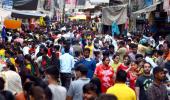Even though the second wave has ebbed, the increased presence of the Delta variant and the subsequent mutations of the coronavirus makes the third wave a real risk for the country, a foreign brokerage has warned.

The risks are real and rising because the pace of vaccination has slowed down to under 3.4 million doses daily from 4 million earlier and also as many as 45 per cent of the daily infections are being reported from rural areas, points Tanvee Gupta-Jain, the chief economist at UBS Securities India.
On the other hand, economic activity has improved sequentially for the seventh consecutive week to July 12, as some states have gradually eased mobility restrictions, notes the report.
Although the second wave is behind us, the risk of a third wave has increased. With the presence of the Delta variant and subsequent mutations of the virus, we consider a third wave a real risk. The number of daily new cases seems to have plateaued but still remains much above the 2021 trough and the decline in active cases has started narrowing, she said in a note on Wednesday.
What is more worrying, according to the report, is the fact that in over 20 per cent of the topic caseload districts where the second has ebbed, the third wave has set in firmly, which was only 5 per cent a month ago.
In over 20 per cent of the districts where the cases have bottomed on daily bases new cases till last week, going by the new cases it is clear that third wave has firmly set in. This compares to only 5 per cent a month ago, she notes in the report.
Another big worry is the slowing pace of vaccinations. Daily doses stood at 3.4 million as of July 12, compared to 4 million in June and 2 million in May, on supply constraints and vaccine hesitancy.
As of July 12, only 381 million doses were administered: while 22.7 per cent of the population above 18 have received the first dose, only a paltry 5.4 per cent of the 900 million who are to be inoculated have received both the doses.
Gupta-Jain further says though economic indicators are normalising they are still mixed. Railway and domestic airline passenger traffic has improved further but toll collections have plateaued for the latest reporting week, according to the UBS-India activity indicator.
Also, while power demand was up 11 per cent partly on summer season demand, railway freight has declined by 1.9 per cent w-o-w and to cap it all vehicle registrations contracted 9 per cent as of July 12, the first time since the last week of May, may be due to the price hike announced by auto companies to offset the increased production cost.
Again, while the labour force participation rate improved to 40.6 per cent from 39.6 per cent end-June, urban and rural unemployment has picked up marginally.
Further, the below-trend monsoons so far could have adversely affected summer crop sowing to the tune of a negative 10 per cent in rural areas.











 © 2025
© 2025